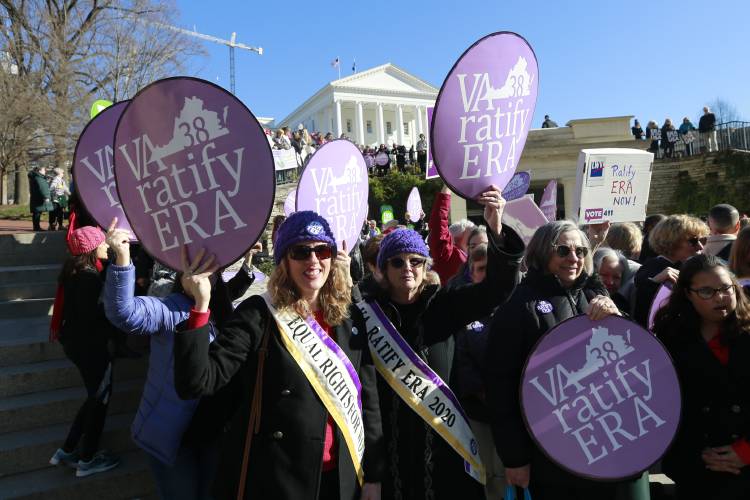


By Dr. Carrie N. Baker, J.D.
Professor of the Study of Women & Gender
Smith College
The Equal Rights Amendment reads, “Equality of rights under the law shall not be denied or abridged by the United States or by any state on account of sex.”
On Jan. 27, 2020, Virginia became the 38th and final state required to ratify the ERA. The ERA is the 28th Amendment to the U.S. Constitution, and the first explicit guarantee of equal rights for women in our country’s founding document. The Trump administration, however, is blocking recognition of the ERA, leaving feminists fuming, and fighting back.
The controversy is over a seven-year timeline for ratification that Congress placed in the preamble of the 1972 amendment. By 1977, 35 states had ratified the amendment, but a conservative backlash stalled further ratifications. Congress extended the timeline for ratification by three years, but no further states ratified the amendment. Until 2017.
After Donald Trump took power, feminists revived the fight for the ERA. Trump’s massive rollback of women’s rights made it crystal clear that women needed explicit protection for their equal rights in the Constitution. So feminists got to work.
The first victory occurred in 2017 when Democrats took control of the Nevada Legislature and ratified the ERA. In the summer of 2018, Illinois ratified. And then on Jan. 27, 2020, Virginia became the 38th and final state needed to ratify the amendment. A bipartisan majority approved the ERA in all three of these states.
In order for a ratified amendment to officially become part of the Constitution, the archivist of the United States must certify the adoption of the amendment to the U.S. Constitution. On Jan. 6, Attorney General William Barr’s Department of Justice issued a 38-page opinion arguing that the ERA should not be certified. U.S. Archivist David Ferriero then announced that he would not certify the amendment.
But even before the final required state ratified the amendment, attorneys general from Alabama, Louisiana and South Dakota filed a federal lawsuit in December alleging that the timeline in the preamble to the ERA should render recent ratification votes moot.
In response, attorneys general from the three states that recently ratified the ERA — Mark Herring in Virginia, Kwame Raoul in Illinois and Aaron Ford in Nevada — filed a civil rights lawsuit in late January arguing that the timeline for ratification is not binding because it appeared in the preamble to the amendment, not in the text of the amendment ratified by the 38 states. Noting that the timeline was extended once already, they argue that it can be extended again. They also note that the 27th Amendment, which was sent to the states in 1789, was not fully ratified and added to the Constitution until 203 years later in 1992.
In addition to attempting to get recognition for the ERA in the courts, feminists have turned to Congress. On Feb. 14, under the leadership of House Speaker Nancy Pelosi, the U.S. House passed a resolution eliminating the timeline for ratification. But Senate Majority Leader Mitch McConnell has vowed to block the resolution, saying that he’s “personally not a supporter” of the ERA. Therefore, ERA advocates have set their sights on flipping the Senate in November.
In polls, 75% of respondents support the ERA, both men and women, and most think the ERA is already a part of the Constitution. In fact, the U.S. is one of only a handful of countries in the entire world without explicit protection for women’s rights in its Constitution.
In the U.S., the Supreme Court has interpreted the 14th Amendment’s Equal Protection Clause to provide only limited equality protections against sex discrimination. But even these limited protections could easily be overturned by the Supreme Court. In 2011, Associate Justice Antonio Scalia said in an interview that the Equal Protection Clause should not apply to women because it was not intended to do so in 1868 when it was passed. The current conservative majority on the court could easily follow Scalia’s reasoning by reinterpreting the Constitution to eliminate constitutional equality protections for women.
Statutory equality protections can also be weakened. Women have made numerous gains over the past several decades — from Title VII barring sex discrimination in employment to the Pregnancy Discrimination Act, educational equity from Title IX to the Violence Against Women Act, and much more. But all these federal legislative gains can be wiped out by a hostile Congress or Supreme Court, and have been chipped away slowly and insidiously. Over the last three years, the Trump administration has been steadily rolling back women’s rights under these laws through administrative agency decisions.
So while there is a patchwork of constitutional and statutory provisions to prohibit some forms of sex discrimination in some circumstances, many of these provisions have been undermined, overturned, and even repealed, and all of them are subject to elimination by the current conservative majority on the U.S. Supreme Court. The ERA, on the other hand, would give lawmakers the power to pass stronger laws to address sex discrimination and violence against women.
“If our rights are in the Constitution, they can’t be erased or rolled back by the changing political whims of legislators, judges or occupants of the White House,” says Rep. Carolyn Maloney, D-NY. “Women’s equality will be spelled out in the Constitution. And we will spell it E-R-A.”
In this centennial anniversary of the 19th Amendment and women’s right to vote, it’s long past due to add the Equal Rights Amendment to the U.S. Constitution and finally guarantee women’s equal rights, forever.
Originally published by the Daily Hampshire Gazette, 02.26.2020, republished under non-indexable fair use.
